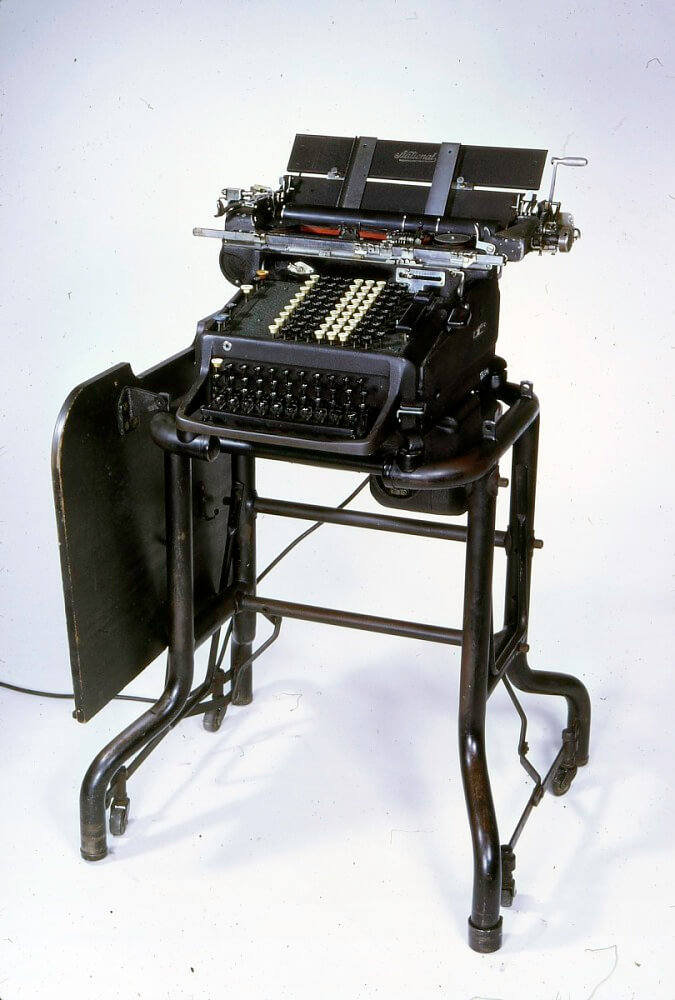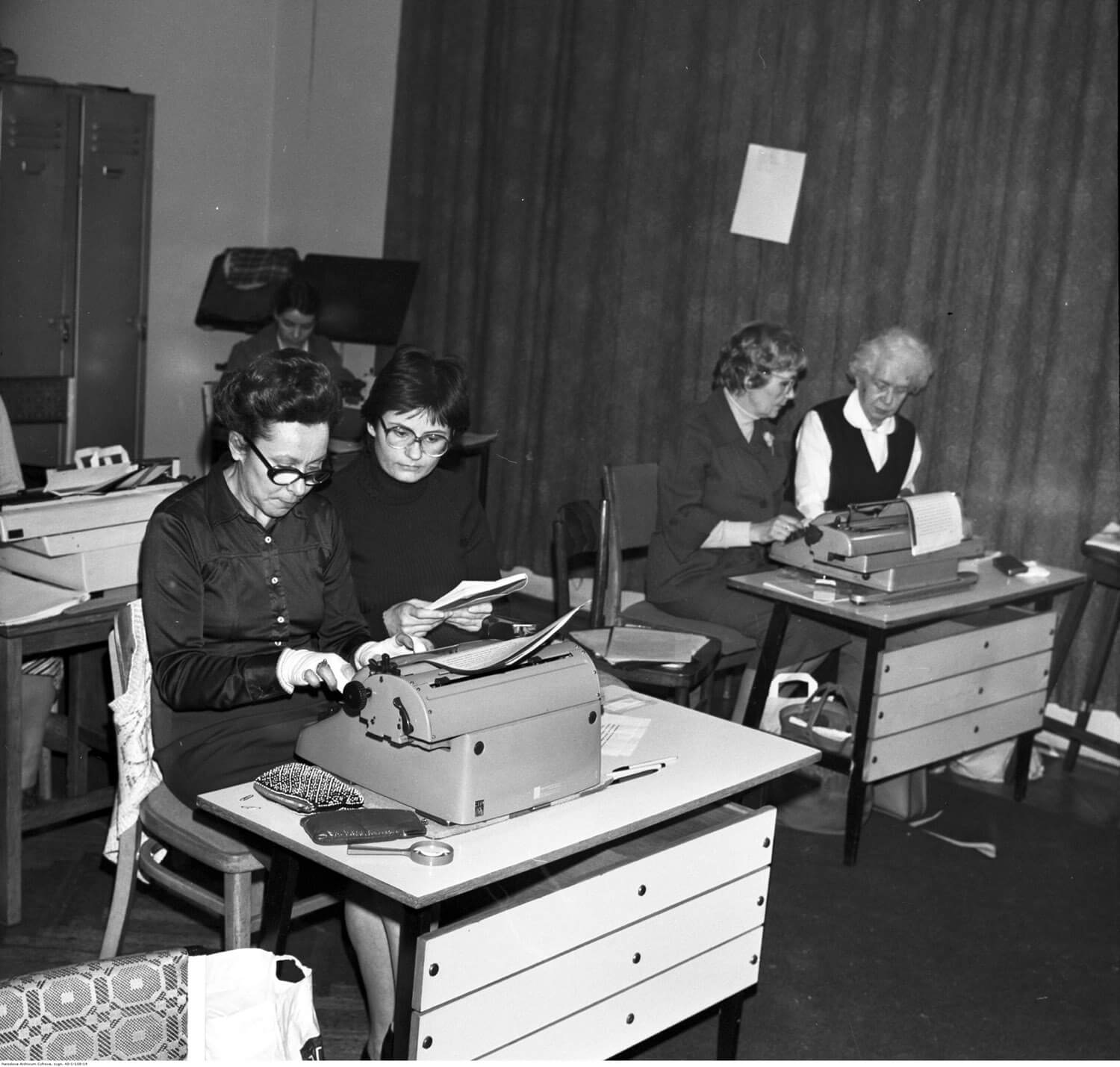National accounting machine︎
National accounting machine, inventory No. MIM 405/ VII/63; created: approx. 1940; manufacturer: National Register Kassen G.m.b.H.; location: Berlin, Germany; materials: steel, aluminium, plastics; dimensions [mm]: H 970, W 500, L 720.



The National accounting machine, from approximately 1940, is an office work instrument that is also dubbed “the old Excel” due to the tasks it executed. It was a specialized electric machine used to develop statistics, financial and investment plans, as well as documents or materials that required the adding of text and calculations on the same side of a page. It could be found in offices providing services for large enterprises, financial institutions, and tax authorities.
Accounting machines were not usually assigned to a singular employee or to their job position but were made available to a large number of people working in a given office. Although being heavy, weighing in at 85 kg, they were moved as needed, since they were permanently fixed to a desk-high metal frame, equipped with small wheels and brakes (#portable_work_tool).
The National was an office work mechanization tool. It was supposed to reduce employee fatigue, increase the performance of employees, and reduce costs. Machine electrification was aimed at reducing the physical effort put into hitting the keys, and at accelerating typing and calculating. When creating such devices, much attention was paid to their ergonomics. As such, they were fitted with “keys made solely of plastic, highly rounded, with fingertip recesses”. Working with such machines was becoming more and more repeatable and boring, whilst also become faster (#automation #effort #ergonomics #repetitive_work #boredom #pace_of_work #stressful_work #exertion #deskilling #labour_intensity).
Office tasks were, and still are, subject to strong gender-based stereotypes which have established certain hierarchies between employees and positions. Equipment such as the National was assigned to female office workers, which was clearly expressed in the descriptions of the machines within trade school textbooks and in their advertisements. In both representation types, the default office machine operator is a woman. She is supposed to perform suggested physical and device operation exercises. The silhouette of a woman is used to demonstrate the correct and incorrect body positions when working on these devices. Furthermore, it is a woman who receives instructions on the inconvenience of machine keyboard usage with long fingernails (#work_representations #employee_segregation_due_to_gender #work_genderisation).
Advertisements are dominated by images containing typists and office managers in hierarchical depictions. In such adverts, the man’s stance is usually casual yet imperious, while a female operator bends over the machine. Towering over the woman, he gives her orders or dictates a text, with the woman executing the assigned task. The typist seems to be a sort of a device extension – she automatically writes down the content created and organized by the office boss, without displaying any initiative of her own (#employee_segregation_due_to_gender #work_genderisation #work_representations #work_control).
Working with the National machine, just like with any other typewriter or adding machine, required the adaptation of the body to such an activity. Industry textbooks suggested finger and hand exercises, and rules regarding proper body position at work. The objective of the exercises was to learn the correct typing system. Non-systematic typing facilitates around three hundred hits per minute, while systematic facilitates up to five hundred. A correct typing system is less tiring as it entails the automation of certain activities; repeating actions improves finger dexterity and eventually the typist “stops thinking about them at all”. A proper technique also avoids the generation of extreme noise by the machine. A novice stenographer will hit the key irregularly, and the varying rate will create loud noises of uneven frequency that will be a nuisance for the stenographer and the surrounding work colleagues. Finger and hand flexibility is useful when typing, and it can be trained. Exercises focus on the pinky and ring fingers, which are the least agile due to tendon adhesion and relative infrequent use (#work_adaptation #repetative_work #ohs #body_positions #training #noise #exertion).
︎
Accounting machines were not usually assigned to a singular employee or to their job position but were made available to a large number of people working in a given office. Although being heavy, weighing in at 85 kg, they were moved as needed, since they were permanently fixed to a desk-high metal frame, equipped with small wheels and brakes (#portable_work_tool).
The National was an office work mechanization tool. It was supposed to reduce employee fatigue, increase the performance of employees, and reduce costs. Machine electrification was aimed at reducing the physical effort put into hitting the keys, and at accelerating typing and calculating. When creating such devices, much attention was paid to their ergonomics. As such, they were fitted with “keys made solely of plastic, highly rounded, with fingertip recesses”. Working with such machines was becoming more and more repeatable and boring, whilst also become faster (#automation #effort #ergonomics #repetitive_work #boredom #pace_of_work #stressful_work #exertion #deskilling #labour_intensity).
Office tasks were, and still are, subject to strong gender-based stereotypes which have established certain hierarchies between employees and positions. Equipment such as the National was assigned to female office workers, which was clearly expressed in the descriptions of the machines within trade school textbooks and in their advertisements. In both representation types, the default office machine operator is a woman. She is supposed to perform suggested physical and device operation exercises. The silhouette of a woman is used to demonstrate the correct and incorrect body positions when working on these devices. Furthermore, it is a woman who receives instructions on the inconvenience of machine keyboard usage with long fingernails (#work_representations #employee_segregation_due_to_gender #work_genderisation).
Advertisements are dominated by images containing typists and office managers in hierarchical depictions. In such adverts, the man’s stance is usually casual yet imperious, while a female operator bends over the machine. Towering over the woman, he gives her orders or dictates a text, with the woman executing the assigned task. The typist seems to be a sort of a device extension – she automatically writes down the content created and organized by the office boss, without displaying any initiative of her own (#employee_segregation_due_to_gender #work_genderisation #work_representations #work_control).
Working with the National machine, just like with any other typewriter or adding machine, required the adaptation of the body to such an activity. Industry textbooks suggested finger and hand exercises, and rules regarding proper body position at work. The objective of the exercises was to learn the correct typing system. Non-systematic typing facilitates around three hundred hits per minute, while systematic facilitates up to five hundred. A correct typing system is less tiring as it entails the automation of certain activities; repeating actions improves finger dexterity and eventually the typist “stops thinking about them at all”. A proper technique also avoids the generation of extreme noise by the machine. A novice stenographer will hit the key irregularly, and the varying rate will create loud noises of uneven frequency that will be a nuisance for the stenographer and the surrounding work colleagues. Finger and hand flexibility is useful when typing, and it can be trained. Exercises focus on the pinky and ring fingers, which are the least agile due to tendon adhesion and relative infrequent use (#work_adaptation #repetative_work #ohs #body_positions #training #noise #exertion).
︎